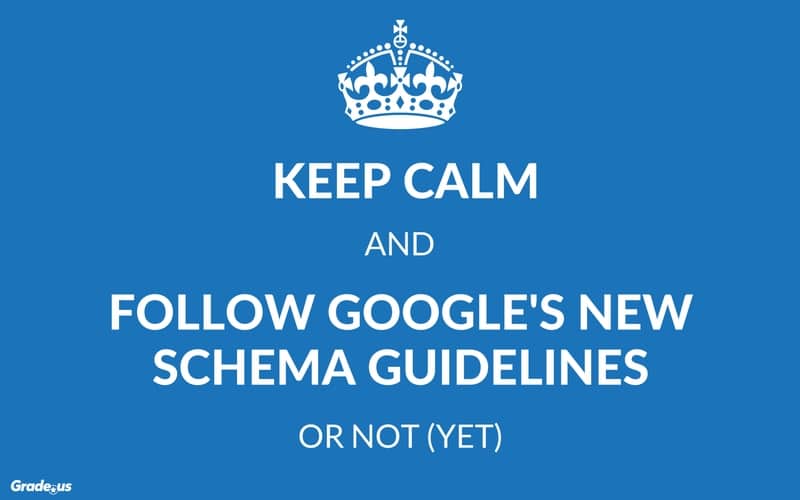TL;DR for busy users of Grade.us:
Google made recent changes to its guidelines for local businesses using schema markup on review content. These guidelines pertain only to local businesses who publish review content on their website in schema markup.
These guidelines do not pertain to how you acquire new reviews or even how you showcase them on your website. They are about Google’s criteria for the use of schema markup. As such, these changes do NOT affect users of our services, not even our “Review Stream” widget. (The widget is loaded from Javascript and its content is not indexed by Google.)
The changes may affect users of our WordPress plugin (or Joomla/Drupal modules) in the future. So far there isn’t any evidence that Google is enforcing the new guidelines, but those who want to follow the new guidelines to the letter can install the latest update of the WordPress plugin and choose “No schema” or “Use schema only on reviews collected directly?”
As often happens when Google sneezes, marketers and SEOs are whipped into a frenzy of hand-wringing and speculation. We wonder: Am I doing it wrong? Will I be penalized? Will I lose my clients? My job? My house?! My spouse?!!
This month, the Big G threw us its latest curveball: new guidelines for use of schema markup on review content for local businesses. Not to be accused of consistency, Google made sure these guidelines directly contradicted its previous guidelines, a change that stirred up local SEO forums–and our own support channel–with many questions and recommendations when it made headlines yesterday.
I’ve been getting a flood of emails myself, and I think it’s important to reiterate:
These guidelines pertain only to local businesses who publish review content on their website in schema markup.
These guidelines do not pertain to how you acquire new reviews or even how you showcase them on your website. They are about Google’s criteria for the use of schema markup. Period. That’s it.
If you don’t know what “schema markup” is, you probably don’t need to read further. For the rest of you, I have only one recommendation at this time: Take a deep breath. Better? Okay, now let’s look at these hyped-up changes in some detail.
Background on Schema Markup, Rich Snippets and Google
With respect to reviews, schema markup is simply a way of structuring review content on a web page that identifies a review as a review to search engines. It structures the data for Google’s consumption by clearly identifying the rating, the author, the date, etc.
Using schema markup for review content can bring a nice little visibility perk for pages with enough PageRank, i.e. pages that have earned Google’s trust. Namely, those pages can sometimes show up in search results with the star rating “rich snippet”:
As a result, over the years many local SEOs have gathered up their clients’ reviews (or unscrupulously made them up), marked them up with schema, and placed them on the business website hoping for this little bit of extra love from Google’s algorithm.
And Google gaveth. The question is: Will Google now taketh away?
Grade.us and Schema Markup
First, I’d like to address Grade.us users directly because you are the audience I care most about: The vast majority of you showcase your (or your clients’) latest and greatest reviews with our “Review Stream” widget, a standard copy/paste embeddable widget that is rendered with Javascript and not indexed by Google. Therefore, the new guidelines have no bearing on you.
Users of our “Review Stream” WordPress plugin (and Joomla/Drupal modules) do take advantage of schema markup on the reviews themselves as well as the aggregate rating submitted to Google and often used in rich snippets.
To date, this approach has been very successful. We’ve attributed that success to good, common-sense Internet citizenship and our fidelity to Google’s “old” guidelines (from earlier this year, LOL). The WordPress plugin:
- excerpts and links back to legitimate reviews from independent review publishers
- renders reviews visibly on the page rather than as invisible metadata, such as JSON-LD
- allows the business to choose what reviews to amplify (this is their business website, after all), but uses an aggregate rating for schema that cannot be manipulated
Rather than publishing only “original” reviews, this approach includes reviews from high-quality third-party publishers like Google, Facebook and Yelp, while respecting the interests of publishers, business owners and consumers alike.
So What Changed? Google’s Criteria for Reviews with Schema Markup
On August 4, Google updated its guidelines for local businesses who use schema markup for reviews on their websites. Those guidelines are listed all the way at the bottom of their docs, but here they are verbatim:
- Snippets must not be written or provided by the business or content provider unless they are genuine, independent, and unpaid editorial reviews.
- Reviews must allow for customers to express both positive and negative sentiments. They may not be vetted by the business or restricted by the content provider based on the positive/negative sentiment of the review before submission to Google.
- Reviews cannot be template sentences built from data or automated metrics. For example, the following is not acceptable: “Based on X number of responses, on average people experienced X with this business.”
- Reviews for multiple-location businesses such as retail chains or franchises can only be submitted for the specific business location for which they were written. In other words, reviews for multiple-location businesses cannot be syndicated or applied to all business locations of the same company.
- Aggregators or content providers must have no commercial agreements paid or otherwise with businesses to provide reviews.
- Do not include reviews that are duplicate or similar reviews across many businesses or from different sources.
- Only include reviews that have been directly produced by your site, not reviews from third-party sites or syndicated reviews.
Industry people are talking mostly about item #6 because this goes against common practice–not to mention common sense.
Some have also highlighted item #2 which seems to require local businesses to showcase negative reviews on their own websites in order to use schema.
However, in the interest of pointing out the bigger picture here, I’d note that item #5 would effectively eliminate using schema markup with reviews sourced from any review solution or any publisher with whom the business has commercial relationship. Use a commercial review solution? Those reviews are out. Advertise on Yelp or TripAdvisor? Those reviews are out.
Update 2016-09-02: I just heard from Mike Blumenthal of GetFiveStars that Google indicated to him this “jargon-y” guideline pertains to paid-for reviews.
Update 2016-09-07: Google has already updated these guidelines, days after all the hype, and removed most of the items above. The new guidelines for local businesses read simply:
- Ratings must be sourced directly from users.
- Don’t rely on human editors to create, curate or compile ratings information for local
businesses. These types of reviews are critic reviews. - Sites must collect ratings information directly from users and not from other sites.
So the new guidelines represent either Google’s folly in privileging review content of dubious origin (in which case the guidelines won’t last) or a bigger shift for Google towards to respecting review schema only on independent review publisher websites.
Either way, it’s not the end of the world for local businesses.
No Big Loss: Review Schema on Your Website Is SEO Small-ball
While getting a rich-snippet star rating in the SERPs is a nice thing when it happens to your business, let’s put this topic into perspective, shall we? I submit the following points that I have always tried to make about schema markup and rich snippets:
- Rich snippets have been and always will be subject to Google’s whim, which changes frequently if you haven’t noticed
- Given the many other vectors for discovery of a local business, review rich snippets account for a very small visibility gain for the business overall
- Why? Because rich snippets mostly show only for branded searches, a small subset of searches made by customers who already know and are looking for your business by name
- Much greater gains are made by generating reviews on the third-party review and directory sites that customers use to discover and evaluate businesses
- Arguably the most important role of a local business website is to convert the prospects who land there and therefore it should showcase the review content best suited to that purpose
Among all the factors that matter for generating leads and converting prospects for local businesses, schema-fied reviews hardly rank. That’s not to say we shouldn’t take advantage of them if we can, of course.
Future-Proofing: What to Do Next
Frankly, it’s too early to tell whether any action should be taken to follow the new guidelines. Let’s not forget that Google is always changing the rules, and there is currently zero evidence that these new guidelines are being enforced or that they will stick.
In the best-case scenario, Google continues to bestow the modest reward of a rich snippet on businesses that take advantage of review schema in an acceptable way.
In the worst-case scenario, Google penalizes businesses by removing all their rich snippets–an extreme outcome, to say the least. It’s hard to see Google taking such action against any but the most extreme, spammy perpetrators, especially when the matter is one that they themselves have waffled on for years.
The most likely outcome is… more of the same. By which I mean: more changes! We’re talking about Google, after all. The rules will continue to evolve making new winners and losers by the day, month, and year.
For users of the “Review Stream” WordPress plugin, note that the primary data point used in rich snippets is the aggregate rating. (Note: A rich snippet for review content can either draw from an aggregate rating or an individual marked-up review on the page.) It’s not apparent that the aggregate rating provided by the plugin is at odds with the new guidelines.
Still, those who want to follow the new guidelines to the letter can:
- install the latest update to the “Review Stream” WordPress plugin
- choose “No schema” or “Use schema only on reviews collected directly?”
- if using schema, choose to send all reviews into the stream under Dashboard > Reviews > Settings
As for me, though, I’m holding tight for now. Maybe it’s old-fashioned, but I still put stock in common sense and consistency.











